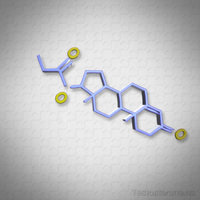Testosterone Promotes Cuddling as well as Aggression.
The word Testosterone conjures up several cliches: It causes aggression, and so makes men mean and edgy...testosterone-induced rampage...huge, artificially-inflated muscles...road  rage fueled by a driver who was a testosterone-loaded maniac...turns men into psycho-sexual maniacs...rabid Tasmanian Devils...produces hard-core, battle-ready, prepared-to-die fearless warriors...these are merely a few of the many misconceptions concerning the “manly hormone.”.
rage fueled by a driver who was a testosterone-loaded maniac...turns men into psycho-sexual maniacs...rabid Tasmanian Devils...produces hard-core, battle-ready, prepared-to-die fearless warriors...these are merely a few of the many misconceptions concerning the “manly hormone.”.
The reality of Testosterone Replacement Therapy (TRT) is that the above description of men and testosterone are grotesque caricatures.
TRT can alleviate the symptoms of older men with low testosterone levels (“Low-T”). For most men, TRT can deliver an impressive energy boost, help to melt away those ever-accumulating pounds, restore strength, and pump new life into their libidos.
For the overwhelming majority of men on TRT, any emotional-laden descriptions mentioned earlier are pure hyperbole.
There is another unexpected effect of testosterone therapy that is often overlooked.
According to a recent Emory University study conducted by neuroscientists on Mongolian gerbils, testosterone can encourage “cuddling.” The study also uncovered a fascinating link between testosterone and oxytocin, the so-called “love hormone.”
For what we believe to be the first time, we have demonstrated that testosterone can directly promote non-sexual and prosocial behavior, in addition to aggression, in the same individual. […] This is surprising because normally we think testosterone increases sexual behavior and aggression. But we have shown that it can have more nuanced effects, depending on the social context,” said Aubrey Kelly, assistant professor of psychology at Emory and a study co-author.
According to Richmond Thompson, a neuroscientist at Emory University’s Oxford College, the other study co-author: "Our hormones are the same, and the parts of the brain they act on are the same. Thus, learning how hormones like testosterone help other animals adapt to rapidly changing social contexts will help us not only to understand the biological workings that affect their behavior but also to predict and ultimately understand how the same molecules in the human brain help shape ours”.
to rapidly changing social contexts will help us not only to understand the biological workings that affect their behavior but also to predict and ultimately understand how the same molecules in the human brain help shape ours”.
These two co-authors should know little about this topic: the two are husband and wife. In addition to marriage, the pair had another reason to collaborate on this research: Kelly’s lab is focused on the neural effects of oxytocin using experimental rodent models.
Thompson’s lab centers on the neural effects of steroids in fish. Both scientists are trying to get at the question of how hormones function in the brain to allow an animal to adapt to changing circumstances depending on the circumstance, quickly.
“The idea for this paper was borne out of us talking together over a glass of wine,” Kelly says. “It blends our two research worlds.”
How the study was conducted
The subjects of the experiments were Mongolian gerbils, chosen because they pair bond and raise their pups together. Although males can become bellicose while mating and guarding their homestead, they also cuddle after a female becomes pregnant and are highly protective when guarding their offspring.
To begin the study, a male gerbil was introduced to a female gerbil. After they bonded and the female became pregnant, the males displayed normal cuddling behaviors toward their partners.
The researchers then gave the male subjects a dose of testosterone. They assumed this testosterone blast would cool his ardor and become the self-centered stereotype of testosterone-loaded males.
“Instead, we were surprised that a male gerbil became even more cuddly and prosocial with his partner,” Kelly says. “He became like ‘super partner.’”
To shake things up, the following experiment was conducted a week later and involved removing the females from the cages leaving each male gerbil all alone in his now empty nest. A strange male visitor was then placed in the cage.
nest. A strange male visitor was then placed in the cage.
“Normally, a male would chase another male that came into its cage or try to avoid it,” Kelly says. “Instead, the resident males that had previously been injected with testosterone were more friendly to the intruder.”
Things quickly changed, however, when the first male subjects were given a second jab of testosterone. They then began showing the new roommate the usual chasing and avoidance behaviors.
“It was like they suddenly woke up and realized they weren’t supposed to be friendly in that context,” Kelly says.
The researchers hypothesized that since the males experienced a boost in testosterone while with their partners, it not only suddenly raised good feelings toward them but also programmed the males to act friendlier in the future, even when the circumstances changed and another potential rival male was present.
However, the second testosterone dose quickly made them more aggressive when close to the male invader. “It appears that testosterone enhances context-appropriate behavior,” Kelly says. “It seems to play a role in amplifying the tendency to be cuddly and protective or aggressive.”
The Study Conclusions
These experiments replicated what the males might experience in the wild. In their natural habitat, Kelly stated, mating with a partner boosts testosterone, which primes them to act cuddly with their partner immediately and soon, even as their testosterone levels ebb.
If a rival male broke into the nest, the male gerbil would likely experience another testosterone surge and quickly switch into battle mode to ward off the rival male and protect his pups. Testosterone can help animals swiftly change between friendly and non-friendly responses as the situation changes.
The results also demonstrated that male gerbils given testosterone exhibited more oxytocin activity in their brains during interfaces with a partner than males not treated with testosterone.
“We know that systems of oxytocin and testosterone overlap in the brain, but we don’t really understand why,” Kelly says. “Taken together, our results suggest that one of the reasons for this overlap may be so they can work together to promote prosocial behavior.”
Instead of pushing an “on” or “off” button to dictate behaviors, hormones are more nuanced, Kelly says. “It‘s like a complicated dashboard where one dial may need to move up a bit while another one moves down.”
“Our hormones are the same, and the parts of the brain they act upon are even the same,” Thompson says. “So, learning how hormones like testosterone help other animals adjust to rapidly changing social contexts will not only help us understand the biological nuts and bolts that affect their behavior but also predict and ultimately understand how the same molecules in human brains help shape our own responses to the social world around us.”
Of course, humans are substantially more complicated than Mongolian gerbils, so these results might not translate precisely to people. The researchers understand that but sincerely hope their conclusions and discoveries will lead to similar studies in other species, including humans.
Contact us for a FREE, no-obligation discussion concerning the incredible benefits of Testosterone Replacement Therapy (TRT)!
Contact Us For A Fast And Professional Response

- Cheyenne Sermorelin for HGH Deficiency [Last Updated On: April 6th, 2023] [Originally Added On: November 3rd, 2018]
- Milwaukee Sermorelin for HGH Deficiency [Last Updated On: April 19th, 2023] [Originally Added On: November 3rd, 2018]
- Madison Sermorelin for HGH Deficiency [Last Updated On: February 14th, 2023] [Originally Added On: November 3rd, 2018]
- Green Bay Sermorelin for HGH Deficiency [Last Updated On: May 10th, 2023] [Originally Added On: November 3rd, 2018]
- Charleston Sermorelin for HGH Deficiency [Last Updated On: February 26th, 2023] [Originally Added On: November 3rd, 2018]
- Vancouver Sermorelin for HGH Deficiency [Last Updated On: October 2nd, 2023] [Originally Added On: November 3rd, 2018]
- Tacoma Sermorelin for HGH Deficiency [Last Updated On: May 28th, 2023] [Originally Added On: November 3rd, 2018]
- Spokane Sermorelin for HGH Deficiency [Last Updated On: March 23rd, 2023] [Originally Added On: November 3rd, 2018]
- Seattle Sermorelin for HGH Deficiency [Last Updated On: May 16th, 2023] [Originally Added On: November 3rd, 2018]
- Bellevue Sermorelin for HGH Deficiency [Last Updated On: March 6th, 2023] [Originally Added On: November 3rd, 2018]
- Virginia Beach Sermorelin for HGH Deficiency [Last Updated On: March 23rd, 2023] [Originally Added On: November 3rd, 2018]
- Richmond Sermorelin for HGH Deficiency [Last Updated On: April 23rd, 2023] [Originally Added On: November 3rd, 2018]
- Portsmouth Sermorelin for HGH Deficiency [Last Updated On: February 18th, 2023] [Originally Added On: November 3rd, 2018]
- Norfolk Sermorelin for HGH Deficiency [Last Updated On: October 12th, 2023] [Originally Added On: November 3rd, 2018]
- Newport News Sermorelin for HGH Deficiency [Last Updated On: January 7th, 2023] [Originally Added On: November 3rd, 2018]
- Hampton Sermorelin for HGH Deficiency [Last Updated On: April 17th, 2023] [Originally Added On: November 3rd, 2018]
- Chesapeake Sermorelin for HGH Deficiency [Last Updated On: March 27th, 2023] [Originally Added On: November 3rd, 2018]
- Arlington, Virginia Sermorelin for HGH Deficiency [Last Updated On: July 24th, 2023] [Originally Added On: November 3rd, 2018]
- Alexandria Sermorelin for HGH Deficiency [Last Updated On: May 27th, 2023] [Originally Added On: November 3rd, 2018]
- Montpelier Sermorelin for HGH Deficiency [Last Updated On: May 2nd, 2023] [Originally Added On: November 3rd, 2018]
- West Valley City Sermorelin for HGH Deficiency [Last Updated On: December 27th, 2023] [Originally Added On: November 3rd, 2018]
- West Jordan Sermorelin for HGH Deficiency [Last Updated On: April 27th, 2023] [Originally Added On: November 3rd, 2018]
- Salt Lake City Sermorelin for HGH Deficiency [Last Updated On: July 11th, 2023] [Originally Added On: November 3rd, 2018]
- Provo Sermorelin for HGH Deficiency [Last Updated On: March 11th, 2023] [Originally Added On: November 4th, 2018]
- Wichita Falls Sermorelin for HGH Deficiency [Last Updated On: May 26th, 2023] [Originally Added On: November 4th, 2018]
- Waco Sermorelin for HGH Deficiency [Last Updated On: February 19th, 2023] [Originally Added On: November 4th, 2018]
- San Antonio Sermorelin for HGH Deficiency [Last Updated On: November 5th, 2023] [Originally Added On: November 4th, 2018]
- Round Rock Sermorelin for HGH Deficiency [Last Updated On: November 11th, 2023] [Originally Added On: November 4th, 2018]
- Richardson Sermorelin for HGH Deficiency [Last Updated On: February 7th, 2023] [Originally Added On: November 4th, 2018]
- Plano Sermorelin for HGH Deficiency [Last Updated On: July 18th, 2023] [Originally Added On: November 4th, 2018]
- Pasadena Sermorelin for HGH Deficiency [Last Updated On: September 7th, 2023] [Originally Added On: November 4th, 2018]
- Midland Sermorelin for HGH Deficiency [Last Updated On: November 22nd, 2023] [Originally Added On: November 4th, 2018]
- Mesquite Sermorelin for HGH Deficiency [Last Updated On: October 22nd, 2023] [Originally Added On: November 4th, 2018]
- McKinney Sermorelin for HGH Deficiency [Last Updated On: December 21st, 2023] [Originally Added On: November 4th, 2018]
- McAllen Sermorelin for HGH Deficiency [Last Updated On: February 17th, 2023] [Originally Added On: November 4th, 2018]
- Lubbock Sermorelin for HGH Deficiency [Last Updated On: September 10th, 2023] [Originally Added On: November 4th, 2018]
- Lewisville Sermorelin for HGH Deficiency [Last Updated On: September 7th, 2023] [Originally Added On: November 4th, 2018]
- Laredo Sermorelin for HGH Deficiency [Last Updated On: August 10th, 2023] [Originally Added On: November 4th, 2018]
- Killeen Sermorelin for HGH Deficiency [Last Updated On: February 23rd, 2023] [Originally Added On: November 4th, 2018]
- Irving Sermorelin for HGH Deficiency [Last Updated On: April 29th, 2023] [Originally Added On: November 4th, 2018]
- Houston Sermorelin for HGH Deficiency [Last Updated On: October 2nd, 2023] [Originally Added On: November 4th, 2018]
- Grand Prairie Sermorelin for HGH Deficiency [Last Updated On: May 18th, 2023] [Originally Added On: November 4th, 2018]
- Garland Sermorelin for HGH Deficiency [Last Updated On: March 7th, 2023] [Originally Added On: November 4th, 2018]
- Fort Worth Sermorelin for HGH Deficiency [Last Updated On: October 28th, 2023] [Originally Added On: November 4th, 2018]
- El Paso Sermorelin for HGH Deficiency [Last Updated On: January 8th, 2023] [Originally Added On: November 4th, 2018]
- Denton Sermorelin for HGH Deficiency [Last Updated On: February 21st, 2023] [Originally Added On: November 4th, 2018]
- Dallas Sermorelin for HGH Deficiency [Last Updated On: April 30th, 2023] [Originally Added On: November 4th, 2018]
- Corpus Christi Sermorelin for HGH Deficiency [Last Updated On: July 30th, 2023] [Originally Added On: November 4th, 2018]
- Carrollton Sermorelin for HGH Deficiency [Last Updated On: February 4th, 2023] [Originally Added On: November 4th, 2018]
- Brownsville Sermorelin for HGH Deficiency [Last Updated On: April 10th, 2023] [Originally Added On: November 4th, 2018]
- Beaumont Sermorelin for HGH Deficiency [Last Updated On: November 27th, 2023] [Originally Added On: November 4th, 2018]
- Austin Sermorelin for HGH Deficiency [Last Updated On: May 13th, 2023] [Originally Added On: November 4th, 2018]
- Arlington Sermorelin for HGH Deficiency [Last Updated On: April 16th, 2023] [Originally Added On: November 4th, 2018]
- Amarillo Sermorelin for HGH Deficiency [Last Updated On: May 14th, 2023] [Originally Added On: November 4th, 2018]
- Abilene Sermorelin for HGH Deficiency [Last Updated On: December 26th, 2023] [Originally Added On: November 4th, 2018]
- Nashville Sermorelin for HGH Deficiency [Last Updated On: March 16th, 2023] [Originally Added On: November 4th, 2018]
- Murfreesboro Sermorelin for HGH Deficiency [Last Updated On: May 18th, 2023] [Originally Added On: November 4th, 2018]
- Memphis Sermorelin for HGH Deficiency [Last Updated On: November 24th, 2023] [Originally Added On: November 4th, 2018]
- Knoxville Sermorelin for HGH Deficiency [Last Updated On: July 16th, 2023] [Originally Added On: November 4th, 2018]
- Clarksville Sermorelin for HGH Deficiency [Last Updated On: July 14th, 2023] [Originally Added On: November 4th, 2018]
- Chattanooga Sermorelin for HGH Deficiency [Last Updated On: May 15th, 2023] [Originally Added On: November 4th, 2018]
- Sioux Falls Sermorelin for HGH Deficiency [Last Updated On: March 5th, 2023] [Originally Added On: November 4th, 2018]
- Columbia Sermorelin for HGH Deficiency [Last Updated On: April 25th, 2023] [Originally Added On: November 4th, 2018]
- Charleston, South Carolina Sermorelin for HGH Deficiency [Last Updated On: October 13th, 2023] [Originally Added On: November 4th, 2018]
- Providence Sermorelin for HGH Deficiency [Last Updated On: April 23rd, 2023] [Originally Added On: November 4th, 2018]
- Pittsburgh Sermorelin for HGH Deficiency [Last Updated On: November 10th, 2023] [Originally Added On: November 4th, 2018]
- Philadelphia Sermorelin for HGH Deficiency [Last Updated On: May 5th, 2023] [Originally Added On: November 4th, 2018]
- Erie Sermorelin for HGH Deficiency [Last Updated On: August 21st, 2023] [Originally Added On: November 4th, 2018]
- Allentown Sermorelin for HGH Deficiency [Last Updated On: February 2nd, 2023] [Originally Added On: November 4th, 2018]
- Salem Sermorelin for HGH Deficiency [Last Updated On: September 25th, 2023] [Originally Added On: November 4th, 2018]
- Portland Sermorelin for HGH Deficiency [Last Updated On: June 29th, 2023] [Originally Added On: November 4th, 2018]
- Gresham Sermorelin for HGH Deficiency [Last Updated On: March 22nd, 2023] [Originally Added On: November 4th, 2018]
- Eugene Sermorelin for HGH Deficiency [Last Updated On: April 30th, 2023] [Originally Added On: November 4th, 2018]
- Tulsa Sermorelin for HGH Deficiency [Last Updated On: September 18th, 2023] [Originally Added On: November 4th, 2018]
- Oklahoma City Sermorelin for HGH Deficiency [Last Updated On: August 22nd, 2023] [Originally Added On: November 4th, 2018]
- Norman Sermorelin for HGH Deficiency [Last Updated On: March 23rd, 2023] [Originally Added On: November 4th, 2018]
- Toledo Sermorelin for HGH Deficiency [Last Updated On: January 29th, 2023] [Originally Added On: November 4th, 2018]
- Dayton Sermorelin for HGH Deficiency [Last Updated On: July 2nd, 2023] [Originally Added On: November 4th, 2018]
- Columbus, Ohio Sermorelin for HGH Deficiency [Last Updated On: July 25th, 2023] [Originally Added On: November 4th, 2018]
- Cleveland Sermorelin for HGH Deficiency [Last Updated On: April 29th, 2023] [Originally Added On: November 4th, 2018]


















